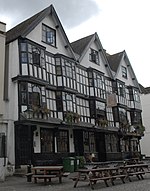Langton House, Bristol
Buildings and structures demolished in 1906Demolished buildings and structures in EnglandJacobean architectureRenaissance architecture in England

Langton House or Langton Mansion located at 12, Welsh Back, Bristol, was a Jacobean house, built by John Langton, a merchant of Bristol who became mayor of the city in 1628. It is notable for its elaborate interiors. The house was demolished in 1906, but much of the internal fittings survive, mostly at New Place, a house in Hampshire designed by Edwin Lutyens.
Excerpt from the Wikipedia article Langton House, Bristol (License: CC BY-SA 3.0, Authors, Images).Langton House, Bristol
Welsh Back, Bristol City Centre
Geographical coordinates (GPS) Address Nearby Places Show on map
Geographical coordinates (GPS)
| Latitude | Longitude |
|---|---|
| N 51.450442 ° | E -2.592515 ° |
Address
Adelina Yard
Welsh Back
BS1 4SL Bristol, City Centre
England, United Kingdom
Open on Google Maps











